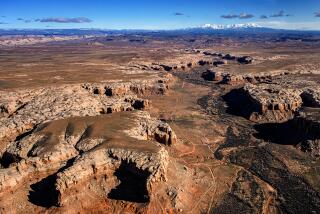Eskimos Worry About Oil-Drilling Threat
- Share via
NUIQSUT, Alaska — In winter, the earth is frozen solid. In summer, it is one of the marshiest places in North America.
For the Nuiqsut Eskimos, this barren coastline that is freezing even on days the sun never sets is where they have hunted caribou, geese and whales for generations.
But it is also where North Slope oil drillers believe an estimated 1 billion barrels worth of oil can be found below the tundra. Thomas Napageak knows this, and he is worried.
“It is our home, where we gather our food,” says Napageak, president of the Nuiqsut’s tribal council. “The price to that is unlimited.”
Recently Interior Secretary Bruce Babbitt arrived to tour the area as his office prepares to rule on whether to open up 23 million acres of the National Petroleum Reserve-Alaska to drilling.
The Interior Department is expected to decide next year--in half the usual time--on drilling leases.
Residents of Nuiqsut feel their fishing and hunting claims are being shoved aside in the rush for fuel. They vented their frustrations as Babbitt toured their village of 450 on the eastern edge of the reserve.
Trying to show Babbitt the importance of the wilderness to their lives, the residents took Babbitt to a hunting and fishing camp, where he saw them butchering fish and game, and on a float trip where he helped haul in a fishing net.
The Eskimos here have shared in the money doled out to those living near the oil fields, but they fear their traditions will be swallowed up as big oil closes in on their homeland.
They are not comforted by state officials and oil companies that say the roads and pipelines will have a minimal effect.
“We were there before the oil fields came, and they tell us we have no right over it,” said Bernice Kaigelak, an Inupiat Eskimo in Nuiqsut. “We are the people of the land. We were here and our ancestors were here.”
Babbitt said he had not realized how vital the land was to the Alaska Natives until he saw their lifestyle firsthand during a 1993 visit.
“I finally understood your presence on the land is absolutely connected to your ability to survive six months of darkness,” Babbitt said at a town meeting.
Hunting and fishing “is not about a sport, it’s not about game. It’s about life and death,” he acknowledged.
Many Alaska Natives said the fish, caribou, whales and fowl they take from the land and water account for most of their diet and many of their cultural trappings. But they also like the cash and conveniences oil has brought, and do not depend solely on wild game for food.
They are among the 7,200 shareholders of the Arctic Slope Regional Corp., which owns much of the North Slope land, and get dividends of thousands of dollars a year.
A good share of the money comes from wells on the reserve’s neighbor, Prudhoe Bay. But the bay’s 13.5-billion-barrel oil field will eventually dry up, and drillers want to start looking elsewhere now.
Ken Thompson, president of Arco Alaska Inc., said the industry is more sensitive to Eskimo culture than it was when oil first flowed through the trans-Alaska pipeline 20 years ago.
Arco has done extensive wildlife studies to reduce the impact of drilling on fish and game, said Thompson.
Gov. Tony Knowles, accompanying Babbitt, said the state is trying to balance the impact of oil development with the Natives’ concerns.
“We want the people to retain their way of life while enjoying high-paying jobs and still be able to go on a fall whale hunt,” Knowles said. “We have to make sure people who depend on the environment to put food on the table can continue to do that.”
More to Read
Sign up for Essential California
The most important California stories and recommendations in your inbox every morning.
You may occasionally receive promotional content from the Los Angeles Times.










